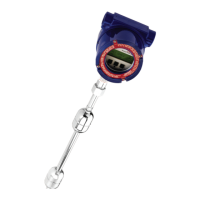Alarm Parameters
The Level Plus monitor provides both software and hardware alarm functions. The soft-
ware alarms are individually programmable and include the following: product low low,
product low, product high, product high high, interface high, interface low, temperature
high, temperature low, mass leak detect, and general gauge failure (gauge inoperative).
Each gauge in the system has independent alarms as described above and can have indi-
vidual limit settings for each alarm function. All of the software alarms can be assigned to
hardware alarms (relay contacts). The Level Plus is available with eight alarm contacts.
Any gauge alarm function can be assigned to any relay output. In addition, the software
supports multiple assignments and cross assignments of relay outputs (each relay output
may represent any combination of software alarm assignments). Programmable dead
band (hysteresis) values are also supported for pump/process control applications. All
alarm information is maintained in the active data array and may be accessed via remote
host communications.
MTS Side Tank Indicator (STI) Support
MTS DDA Side Tank Indicator modules can be connected to the Level Plus monitor sys-
tem to provide display of tank data at remote locations. The devices are multidropped on
the 4-wire MTS DDA network and can be located physically anywhere along the main
cable run. See the Side Tank Indicator Operation and Installation manual for additional
information about this MTS product.
Analog Output Parameters
The Level Plus monitor is provided with eight isolated analog (4-20 milliamp) outputs.
Each output channel can be assigned to any gauge in the system and can be assigned to
track any of the three control parameters (product level, interface level, or temperature).
Volumetric outputs can also be assigned as analog control parameters. Both the 4 mil-
liamp and the 20 milliamp end points are programmable to allow the user to scale the
output values, and inversion of the output channels is also possible. The output channels
can also be programmed to indicate a gauge malfunction alarm by driving the outputs to
either 4 or 20 milliamps.
Volumetric Parameters
The Level Plus Monitor system includes volumetric correction software, which is useful in
many tank gauging applications. The volume software is powerful, fast, and easy to use;
providing the user with gross observed volume (GOV), net standard volume (NSV), and
net mass information. See the section below labeled VOLUMETRIC SUPPORT for addi-
tional information on volume calculations. Programmable volumetric parameters include
the following: temperature correction methods (6A, 6B, 6C, 6C MOD, CUST TAB), display
units (gallons, liters, barrels, pounds, and kilograms), thermal expansion coefficients or
API gravity values, reference temperature (6C MOD only), product density, tank capacities
(optional tank information for ullage calculations), and strapping table information.
Strapping tables can be up to 100 entries per table (8 tables total) and are accessed via
powerful editing software. In addition to basic volume calculations the system incorpo-
rates a static mass stabilization (leak detect) function. The user can program the desired
mass change limits and can assign software and hardware alarms to each tank. Activation
and deactivation of the mass stabilization function is protected through security access
codes.
Volumetric Support
The thermal expansion correction software is based upon standards presented in the
American Petroleum Institute (API) Standard 2540. The Level Plus software strictly
adheres to API guidelines for software implementation, insuring repeatable data accurate
to API tables 6A, 6B, and 6C.
Volume information is calculated real time after the level and temperature data is read
from each gauge and does not affect the overall scan rate of the system. All volume data
is maintained in the active data arrays and is accessible through the host communication
interface. In addition, the software provides error checking on the calculated data and
4

